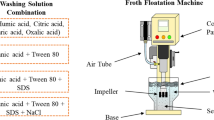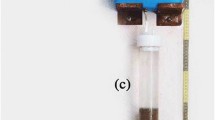Abstract
Large numbers of contaminants such as polycyclic aromatic hydrocarbons, pesticides and chlorophenols pass through sediments and soil, causing a giant danger to human health and ecosystem. To remediate the soil contaminated with these pollutants, various methods have been proposed including coupled soil washing with Fenton or Sono-Fenton process. In this study, non-ionic surfactants [Tween 85 AND linear alkylbenzene sulfonates (LASs)] were used for the removal of chlorpyrifos (organophosphate pesticide). The optimal conditions for LAS surfactant were found to be a concentration of 2.5 g/L with 20/1.5 ratio (liquid/solid), 360 min operation time and 120 rpm washing speed in room temperature; while 1 g/L Tween 85 concentration was more effective at 20:1 ratio (liquid solid), 360 min operation time and 60 rpm washing speed in room temperature, respectively. The results imply that combining both Tween 85 and LAS can be an effective way to remove large amounts of contaminants from soils quickly without damaging them further or harming humans who might come into contact with it afterward. The results of the experimental study on soil washing and Fenton/Sono-Fenton suggest that these two processes combined can be an effective way to remediate soils contaminated with chlorpyrifos. This combination was shown to provide superior results for both remediation and recovery of surfactants used in the cleaning process.








Similar content being viewed by others
References
Alruhaimi RS (2023) Betulinic acid protects against cardiotoxicity of the organophosphorus pesticide chlorpyrifos by suppressing oxidative stress, inflammation, and apoptosis in rats. Environ Sci Pollut Res 30(17):51180–51190
Aswathi A, Pandey A, Sukumaran RK (2019) Rapid degradation of the organophosphate pesticide–Chlorpyrifos by a novel strain of Pseudomonas nitroreducens AR-3. Biores Technol 292:122025
Bae J-Y, Lee D-Y, Oh K-Y, Jeong D-K, Lee D-Y, Kim J-H (2023) Photochemical advanced oxidative process treatment effect on the pesticide residues reduction and quality changes in dried red peppers. Sci Rep 13(1):4444
Befkadu AA, Quanyuan C (2018) Surfactant-enhanced soil washing for removal of petroleum hydrocarbons from contaminated soils: a review. Pedosphere 28(3):383–410
Bolan S, Padhye LP, Mulligan CN, Alonso ER, Saint-Fort R, Jasemizad T, Wang C, Zhang T, Rinklebe J, Wang H (2023) Surfactant-enhanced mobilization of persistent organic pollutants: potential for soil and sediment remediation and unintended consequences. J Hazard Mater 443:130189
Buckley T, Xu X, Rudolph V, Firouzi M, Shukla P (2022) Review of foam fractionation as a water treatment technology. Sep Sci Technol 57(6):929–958
Checa-Fernández A, Santos A, Romero A, Domínguez CM (2023) Remediation of real soils polluted with pesticides by activated persulfate and surfactant addition. J Water Process Eng 53:103829
Chen X, Zhou Q, Liu F, Peng Q, Teng P (2019) Removal of nine pesticide residues from water and soil by biosorption coupled with degradation on biosorbent immobilized laccase. Chemosphere 233:49–56
Cheng S, Lin Q, Wang Y, Luo H, Huang Z, Fu H, Chen H, Xiao R (2020) The removal of Cu, Ni, and Zn in industrial soil by washing with EDTA-organic acids. Arab J Chem 13(4):5160–5170
Cheng C, Liu W, Hou K, Zhang J, Du Z, Li B, Zhu L (2023) Ecological safety evaluation of chlorpyrifos on agricultural soil: Effects on soil microbes. Appl Soil Ecol 189:104954
Dos Santos EV, Sáez C, Martínez-Huitle CA, Cañizares P, Rodrigo MA (2015) Combined soil washing and CDEO for the removal of atrazine from soils. J Hazard Mater 300:129–134
Eren Z (2012) Ultrasound as a basic and auxiliary process for dye remediation: a review. J Environ Manag 104:127–141
Fanaei F, Moussavi G, Shekoohiyan S (2020) Enhanced treatment of the oil-contaminated soil using biosurfactant-assisted washing operation combined with H2O2-stimulated biotreatment of the effluent. J Environ Manag 271:110941
Fuentes MS, Raimondo EE, Amoroso MJ, Benimeli CS (2017) Removal of a mixture of pesticides by a Streptomyces consortium: Influence of different soil systems. Chemosphere 173:359–367
Garcia-Cervilla R, Santos A, Romero A, Lorenzo D (2022) Simultaneous addition of surfactant and oxidant to remediate a polluted soil with chlorinated organic compounds: slurry and column experiments. J Environ Chem Eng 10(3):107625
Gautam P, Bajagain R, Jeong S-W (2020) Combined effects of soil particle size with washing time and soil-to-water ratio on removal of total petroleum hydrocarbon from fuel contaminated soil. Chemosphere 250:126206
Gu F, Zhang J, Shen Z, Li Y, Ji R, Li W, Zhang L, Han J, Xue J, Cheng H (2022) A review for recent advances on soil washing remediation technologies. Bull Environ Contam Toxicol 109(4):651–658
Li C, Sanchez GM, Wu Z, Cheng J, Zhang S, Wang Q, Li F, Sun G, Meentemeyer RK (2020) Spatiotemporal patterns and drivers of soil contamination with heavy metals during an intensive urbanization period (1989–2018) in southern China. Environ Pollut 260:114075
Liu Y, Lonappan L, Brar SK, Yang S (2018) Impact of biochar amendment in agricultural soils on the sorption, desorption, and degradation of pesticides: a review. Sci Total Environ 645:60–70
Ma Y, Mao C, Du X, Xie C, Zhou J, Tao X, Dang Z, Lu G (2023) Insight into the application of magnetic molecularly imprinted polymers in soil-washing effluent: selective removal of 4,4′-dibromodiphenyl ether, high adaptivity of material and efficient recovery of eluent. Chemosphere 334:138990
Malakootian M, Shahesmaeili A, Faraji M, Amiri H, Martinez SS (2020) Advanced oxidation processes for the removal of organophosphorus pesticides in aqueous matrices: A systematic review and meta-analysis. Process Saf Environ Prot 134:292–307
Mirzaee E, Sartaj M (2022) The application of surfactant-enhanced soil washing process combined with adsorption using a recoverable magnetic granular activated carbon for remediation of PAH-contaminated soil. Environmental Advances 9:100274
Nagtode VS, Cardoza C, Yasin HKA, Mali SN, Tambe SM, Roy P, Singh K, Goel A, Amin PD, Thorat BR (2023) Green Surfactants (biosurfactants): a petroleum-free substitute for sustainability—comparison, applications, market, and future prospects. ACS Omega 8(13):11674–11699
Neuwirthová N, Trojan M, Svobodová M, Vašíčková J, Šimek Z, Hofman J, Bielská L (2019) Pesticide residues remaining in soils from previous growing season (s)-Can they accumulate in non-target organisms and contaminate the food web? Sci Total Environ 646:1056–1062
Offiong N-AO, Fatunla OK, Essien JP, Yang C, Dong J (2023) Soil washing of total petroleum and polycyclic aromatic hydrocarbons from crude oil-contaminated ultisol using aqueous extracts of waterleaf. Environ Technol 44(1):35–44
Özdemir C, Öden MK, Şahinkaya S, Güçlü D (2011) The sonochemical decolorisation of textile azo dye CI Reactive Orange 127. Color Technol 127(4):268–273
Prabakaran K, Li J, Anandkumar A, Leng Z, Zou CB, Du D (2019) Managing environmental contamination through phytoremediation by invasive plants: a review. Ecol Eng 138:28–37
Rajagopalan V, Venkataraman S, Rajendran DS, Kumar VV, Kumar VV, Rangasamy G (2023) Acetylcholinesterase biosensors for electrochemical detection of neurotoxic pesticides and acetylcholine neurotransmitter: a literature review. Environ Res 227:115724
Rajak P, Roy S, Ganguly A, Mandi M, Dutta A, Das K, Nanda S, Ghanty S, Biswas G (2023) Agricultural pesticides–friends or foes to biosphere? J Hazard Mater Adv 10:100264
Rajendran S, Priya T, Khoo KS, Hoang TK, Ng H-S, Munawaroh HSH, Karaman C, Orooji Y, Show PL (2022) A critical review on various remediation approaches for heavy metal contaminants removal from contaminated soils. Chemosphere 287:132369
Ramón F, Lull C (2019) Legal measures to prevent and manage soil contamination and to increase food safety for consumer health: the case of Spain. Environ Pollut 250:883–891
Reddy PVL, Kim K-H (2015) A review of photochemical approaches for the treatment of a wide range of pesticides. J Hazard Mater 285:325–335
Ren Y, Li F, Zhai L, Dong D, Han R, Qi X, Zhang X, Li L, Jiang W, Chen X (2023) Tween 80 assisted washing ciprofloxacin-contaminated soil, and recycled it using active chlorines. Environ Pollut 330:121735
Sánchez V, López-Bellido J, Rodrigo MA, Rodríguez L (2019) Enhancing the removal of atrazine from soils by electrokinetic-assisted phytoremediation using ryegrass (Lolium perenne L.). Chemosphere 232:204–212
Silva LM, Silva LR, Motheo AJ (2021) Using niobium/BDD anode-based multi-cell flow reactor for the electrochemical oxidation of methyl paraben in the presence of surfactants. J Water Process Eng 44:102439
Singh S, Haritash A (2019) Polycyclic aromatic hydrocarbons: soil pollution and remediation. Int J Environ Sci Technol (tehran) 16:6489–6512
Sun Y, Li H, Guo G, Semple KT, Jones KC (2019) Soil contamination in China: current priorities, defining background levels and standards for heavy metals. J Environ Manag 251:109512
Sun Y, Wang K, Chen D, Xu Q, Li N, Li H, Lu J (2023) Activation of persulfate by highly dispersed FeCo bimetallic alloy for in-situ remediation of polycyclic aromatic hydrocarbon-contaminated soil. Sep Purif Technol 317:123781
Tao Y, Huang H, Zhang H (2020) Remediation of Cu-phenanthrene co-contaminated soil by soil washing and subsequent photoelectrochemical process in presence of persulfate. J Hazard Mater 400:123111
Tran HT, Lin C, Hoang HG, Bui XT, Vu CT (2022) Soil washing for the remediation of dioxin-contaminated soil: a review. J Hazard Mater 421:126767
Varga B, Somogyi V, Meiczinger M, Kováts N, Domokos E (2019) Enzymatic treatment and subsequent toxicity of organic micropollutants using oxidoreductases—a review. J Clean Prod 221:306–322
Vryzas Z (2018) Pesticide fate in soil-sediment-water environment in relation to contamination preventing actions. Curr Opin Environ Sci Health 4:5–9
Wang G, Pan X, Zhang S, Zhong Q, Zhou W, Zhang X, Wu J, Vijver MG, Peijnenburg WJ (2020) Remediation of heavy metal contaminated soil by biodegradable chelator—induced washing: efficiencies and mechanisms. Environ Res 186:109554
Zeb A, Li S, Wu J, Lian J, Liu W, Sun Y (2020) Insights into the mechanisms underlying the remediation potential of earthworms in contaminated soil: a critical review of research progress and prospects. Sci Total Environ 740:140145
Zhen M, Song B, Liu X, Chandankere R, Tang J (2018) Biochar-mediated regulation of greenhouse gas emission and toxicity reduction in bioremediation of organophosphorus pesticide-contaminated soils. Chin J Chem Eng 26(12):2592–2600
Acknowledgements
We thank the Environmental Engineering Department of Aksaray University for providing laboratory equipment of the work described in this paper.
Funding
No funding was received for conducting this study.
Author information
Authors and Affiliations
Contributions
All authors contributed to the study conception and design. Material preparation, data collection and analysis were performed by EB and ŞT. The first draft of the manuscript was written by EB and all authors commented on previous versions of the manuscript. All authors read and approved the final manuscript.
Corresponding author
Ethics declarations
Conflict of interest
The authors report no conflicts of interest. The authors alone are responsible for the content and writing of the paper.
Additional information
Editorial responsibility: Samareh Mirkia.
Rights and permissions
Springer Nature or its licensor (e.g. a society or other partner) holds exclusive rights to this article under a publishing agreement with the author(s) or other rightsholder(s); author self-archiving of the accepted manuscript version of this article is solely governed by the terms of such publishing agreement and applicable law.
About this article
Cite this article
Baştürk, E., Tulun, Ş. Remediation of organophosphate pesticide-contaminated soil using soil washing and advanced oxidation processes. Int. J. Environ. Sci. Technol. 21, 5459–5468 (2024). https://doi.org/10.1007/s13762-023-05351-4
Received:
Revised:
Accepted:
Published:
Issue Date:
DOI: https://doi.org/10.1007/s13762-023-05351-4




